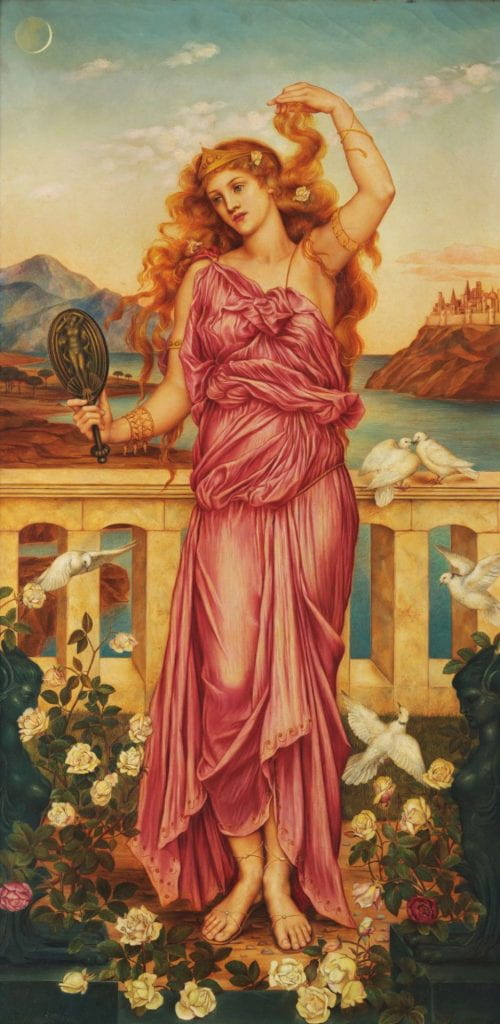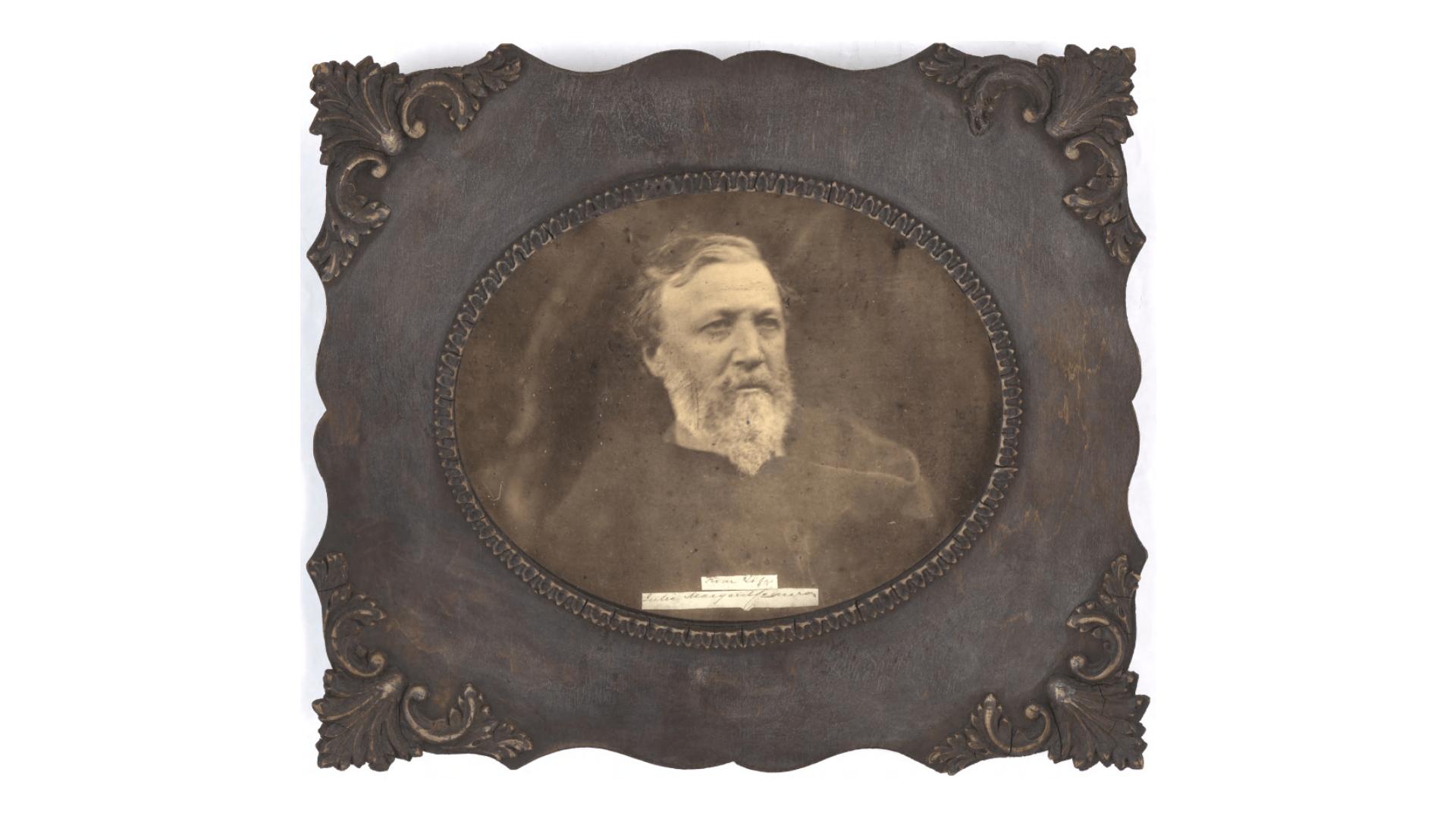By Katrina L. Gallegos, M.A. Candidate, Department of Museum Studies
Currently at the Armstrong Browning Library (ABL) I have an exhibition entitled Mythic Women which explores the theme of the male gaze in Robert Browning’s (RB) poem “Fifine at the Fair” (Fifine). However, this blog post will briefly explore a counterpoint to this theme which I call the female gaze. RB and his corpus of work are firmly situated in the Victorian era which was a time of constraint but also exploration and evolution in art. A subgenre emerged called Pre-Raphaelite which reinterpreted and explored through painting, photography, and poetry classical Roman mythology and other timeless themes such as death and beauty. Many Pre-Raphaelite artists were men who explored via canvas paintings the stories of classic literary characters such as Helen of Troy. These men often illuminated the femininity of their canvases’ subjects using models who in their perception epitomized female beauty. These painting exemplify the male perspective of female beauty and desirability which is contemporarily called the male gaze. However, during this time there was a countermovement of Victorian women artists who were also exploring the themes of death and beauty and reinterpreting classic myths. This post highlights two of these women, mainly Julia Margaret Cameron and Evelyn De Morgan.
Evelyn De Morgan (De Morgan) was born in Great Britain to an upper middle-class family and was privately tutored alongside her brothers, an unusual occurrence during this time. She proved to be an adept artist however her mother and father disapproved of her goal to be an artist. Interestingly, her father allowed her to travel to France and Italy with her uncle to study Old Master paintings. She eventually enrolled in art school in England and developed her skills and won several prizes for her skills in life drawing and composition (De Morgan Collection). During my preliminary research for this exhibition, I came across the works of Evelyn De Morgan and was inspired by her attention to detail in her subjects’ facial expressions and the vividity of colors in her paintings. I then envisioned my exhibition would compare the female and male gazes of Pre-Raphaelite artists and authors and use Fifine as a conduit to explore this era of creativity. However, in the end I decided against this because it took me farther away from Fifine and RB. Evelyn De Morgan was a later contemporary of RB, and it should be noted that while RB may not be considered a Pre-Raphaelite he did move within their broader cultural and professional circles and was a source of inspiration for many of them. As with many artistic movements there is always overlap, a genre or its subject does not belong to a single artist or a single professional group. Artists such as De Morgan were often painting the same subjects as their male counterparts, an example of this overlap can be seen in De Morgan’s rendition of Helen of Troy.
Her interpretation is of a beautiful, blonde statuesque woman draped in a bright pink dress surrounded by doves and white roses. Helen appears to not have a care in the world aside from her own vanity. This rendition is an example of the female gaze, and it is subtle. The way Helen looks at herself in a handheld mirror as she plays with her long, silky hair in a relaxed stance speak to an inner understanding of femininity that only a woman could accurately portray. The paintings composition also evokes a female gaze, Helen does not look at the viewer nor does she look upon Troy, which is in the background; Helen is looking at herself in a beautifully adorned mirror and she is not concerned with history’s opinion of her. As a woman I see and understand De Morgan’s rendition of Helen, she is young and knows her beauty, yet she appears to not understand or recognize its power. Contrast this rendition with the famous male Pre-Raphaelite, Dante Rossetti’s interpretation of Helen of Troy.
From composition to coloring, everything in Rossetti’s rendition is opposite of De Morgan’s. This Helen of Troy is facing the viewer, she is young and wears a heavily draped golden garment, her lips are red, her skin white, and she has voluminous blonde curly hair, her two hands play with a pendant attached to a necklace. The background is blurred with faint outlines of buildings behind her. She is painted from the waist up and appears seated. While she faces the viewer, she does not appear to look directly at us, and her expression gives the appearance of shyness or disinterest. Yet, she appears innocent. Unlike De Morgan’s Helen, this Helen does not seem to be self-aware, she is almost doll-like. This depiction is characteristic of a male gaze perspective on femininity and female beauty, it is something observed from afar and the woman is unaware, inactive participant. Rossetti’s painting is beautiful, and his skills are undeniable but there is no personality nor interest in Helen’s self-beauty. The viewer sees and interacts with his perspective. Although it should be noted that De Morgan also presents her own perspective but, because she is a woman she consciously or subconsciously painted personality and self-awareness into Helen. Both paintings are excellent examples of their era’s trends. As a 21st century woman when I think of Pre-Raphaelite Helen, it is De Morgan’s and not Rossetti’s that comes forth in my mind’s eye.
While De Morgan and Rossetti were sketching and painting other artists were experimenting with the then new technology of photography. Julia Margaret Cameron (Cameron) was an English photographer during the Victorian era and the ABL has ten of her original photographs along with some accompanying correspondence. Cameron subjects were diverse, she had her maid pose as the Virgin Mary/Madonna and she also photographed fellow Victorian artists such as Robert Browning, Tennyson, and Rossetti. This blog page has featured her life and works in several posts linked here and here.
Cameron, like De Morgan, was experimental with her subjects’ composition, while they are clearly modeling for the camera the viewer feels a sense of rawness and excitement when analyzing the photo’s subjects. Sitting for the camera and sitting for a painting are two different experiences for a model, the former allowing for experimentation and vulnerability the latter requiring control and stability. Cameron’s photographs are less adorned than both De Morgan’s and Rossetti’s paintings and she takes multiple shots of the same subject. An example of this is the photograph entitled “Sappho”. The MET Museum and the V&A Museum have original copies but Cameron’s model, Mary Hiller, is posed differently in each photo. The subject is posing to the side and the viewer can see her profile, she wears a necklace and an embroidered top, and her hair is loosely tied back. This style of photo is simple and is opposite of the heavily adorned photographs which were popular during the Victorian era.
- Sappho by Julia Margaret Cameron
- Sappho by Julia Margaret Cameron
This simple style of composition can also be seen in Cameron’s photographs of Robert Browning. The ABL has five original photographs taken during the year 1865. They all appear to be taken during the same sitting, but RB is posed differently in each photo. There is also an intimacy and vulnerability seen in the subject that is evocative of De Morgan’s Helen, Cameron knows her subject and captures his personality and self-awareness without being intrusive. These photographs exemplify the female gaze in artistry, the artist attempts to create relationship with their subject as opposed to imposing their perception of the subject upon the subject.
- Robert Browning by Julia Margaret Cameron
- Robert Browning by Juila Margaret Cameron
The male and female gaze are perceptions, as such they are subjective and contemporaneous to their unique culture and time. My own female gaze perceives society and culture through the lens of a 21st century woman who has her own biases, opinions, and experiences. Given this I still appreciate the artistry of Rossetti, De Morgan, and Cameron as people who, like myself, are attempting to understand culture and society from a unique perspective.
Works Cited
Cameron, Julia Margaret. Robert Browning. 1865. The Armstrong Browning Library & Museum, Waco. The Armstrong Browning Library & Museum, https://digitalcollections-baylor.quartexcollections.com/Documents/Detail/photograph-of-robert-browning/768790. Accessed 15 Oct 2022.
Cameron, Julia Margaret. Robert Browning. 1865. The Armstrong Browning Library & Museum, Waco. The Armstrong Browning Library & Museum, https://digitalcollections-baylor.quartexcollections.com/Documents/Detail/photograph-of-robert-browning/768778. Accessed 15 Oct 2022.
Cameron, Julia Margaret. Sappho. 1865. Victorian & Albert Museum, London. Victoria & Albert Museum, https://collections.vam.ac.uk/item/O130461/sappho-photograph-cameron-julia-margaret/. Accessed 15 Oct 2022.
Cameron, Julia Margaret. Sappho. 1865. The Metropolitan Museum of Art, New York City. The Metropolitan Museum of Art, https://www.metmuseum.org/art/collection/search/282044. Accessed 15 Oct 2022.
Daher, Nadine and Katzman, Lily. “The Women Behind the Pre-Raphaelite Brotherhood.” Smithsonian Magazine, Smithsonian Institution, 22 Jan 2020, https://www.smithsonianmag.com/smart-news/revisiting-women-behind-pre-raphaelite-band-brothers-180974035/. Accessed 15 Oct 2022.
De Morgan, Evelyn. Helen of Troy. 1898. De Morgan Museum, Canon Hall, Barnsley. De Morgan Museum, https://www.demorgan.org.uk/collection/helen-of-troy/. Accessed 15 Oct 2022.
“Evelyn De Morgan.” De Morgan Collection, https://www.demorgan.org.uk/discover/the-de-morgans/evelyn-de-morgan/ Accessed 15 Oct 2022.
Rossetti Archive. Exhibits and Objects, http://www.rossettiarchive.org/docs/s163.rap.html. Accessed 15 Oct 2022.
Rossetti, Dante Gabriel. Helen of Troy. 1863. Hamburger Kunsthalle, Hamburg. Hamburger Kunsthalle, https://online-sammlung.hamburger-kunsthalle.de/en/objekt/HK-2469. Accessed 15 Oct 2022.






